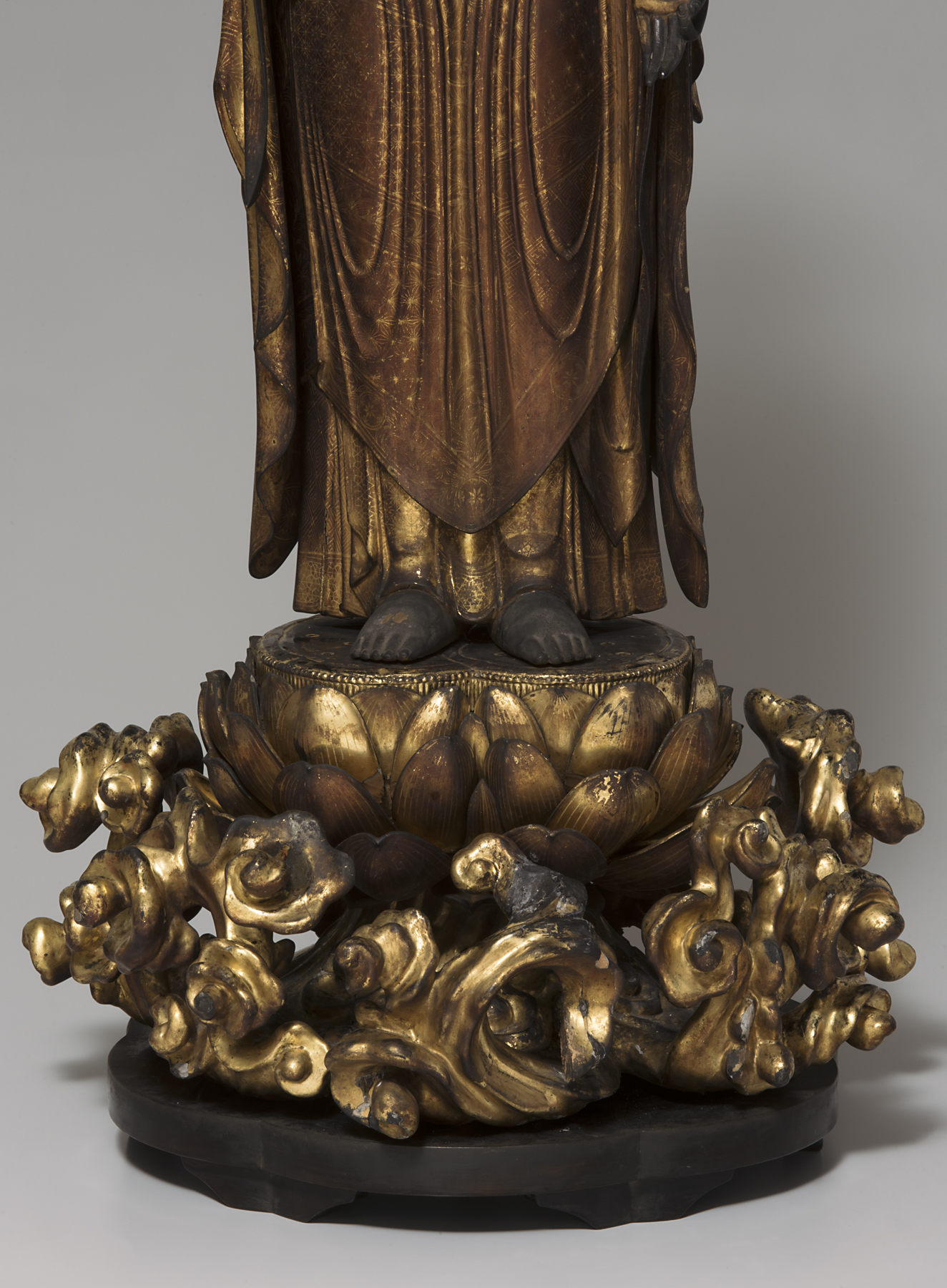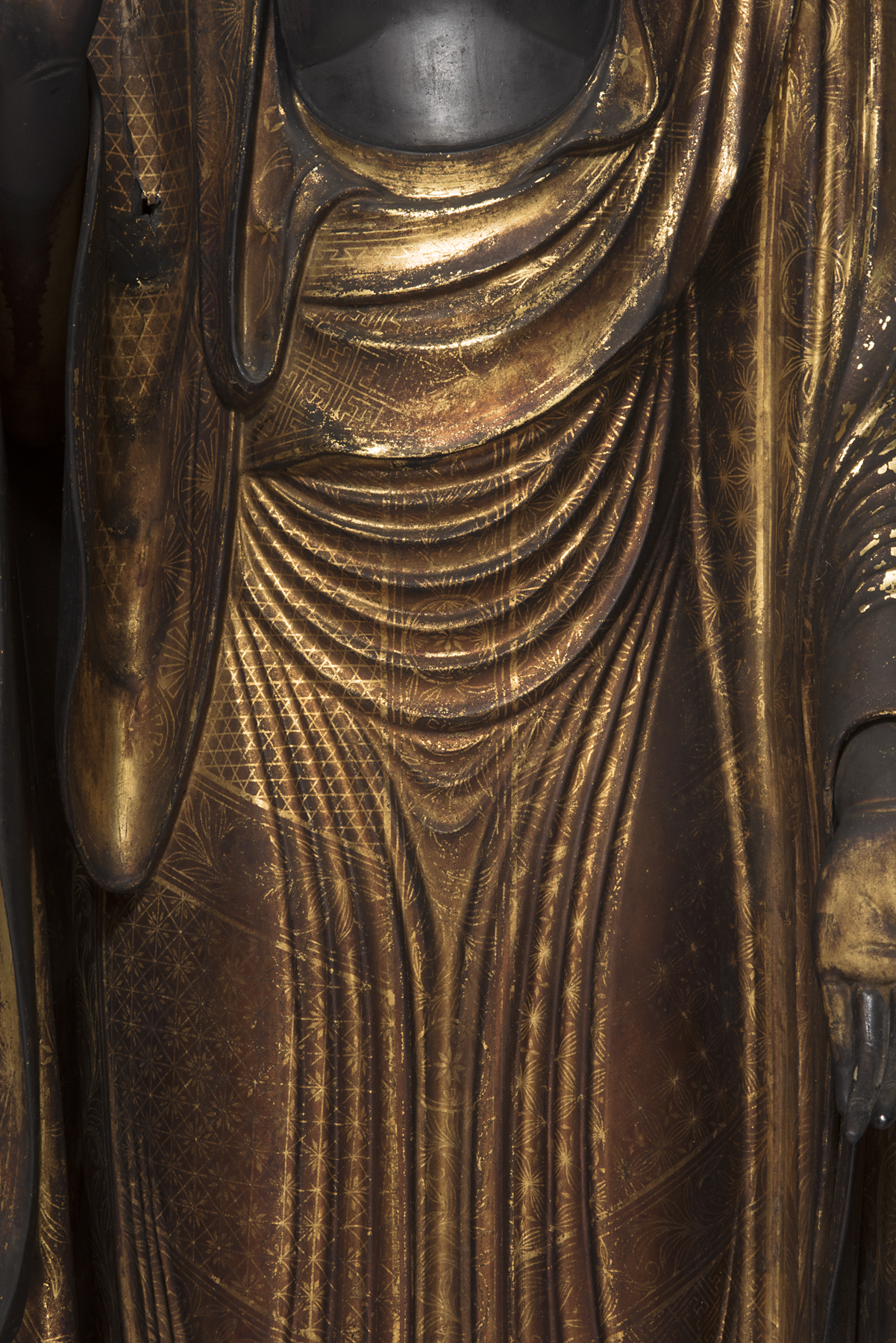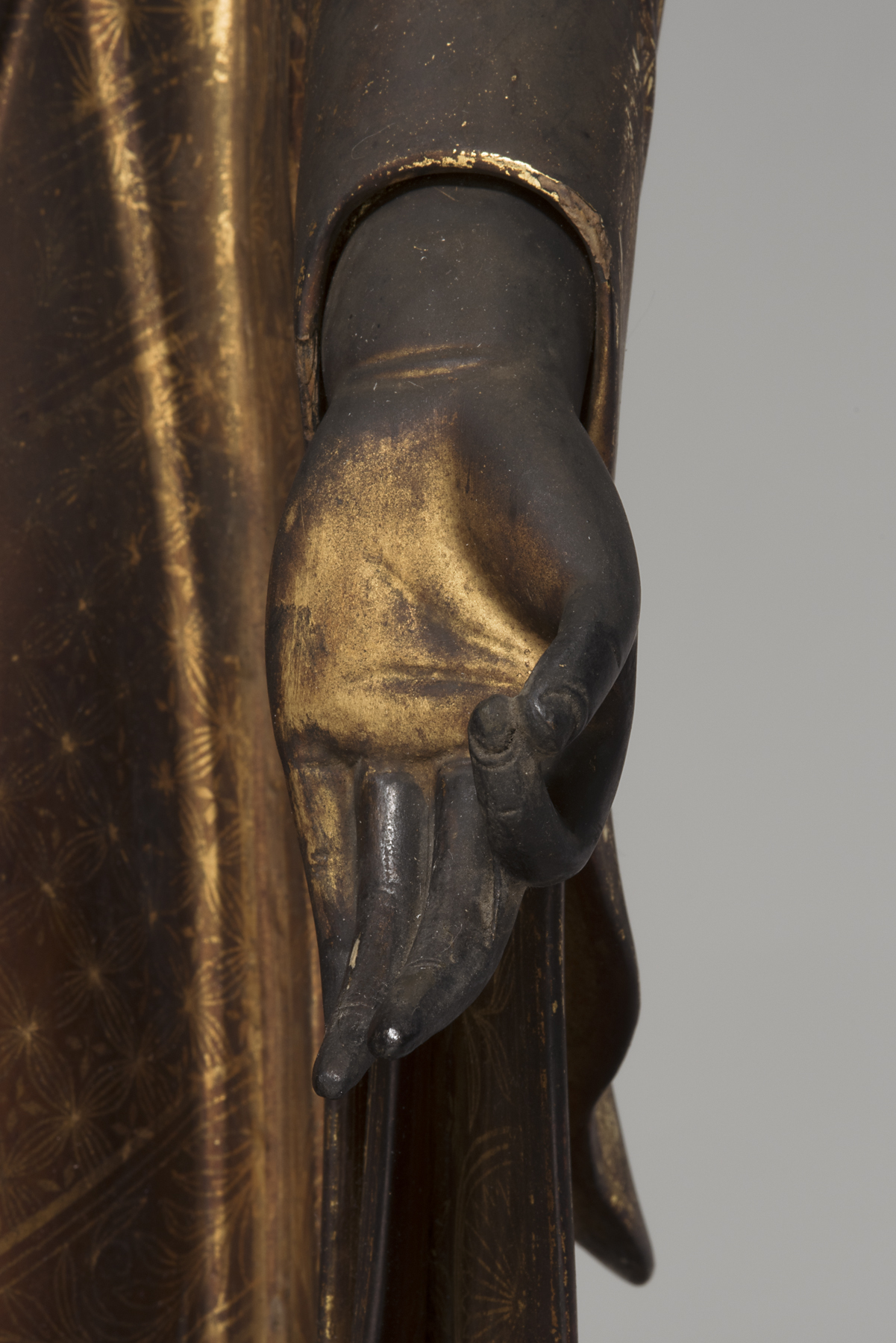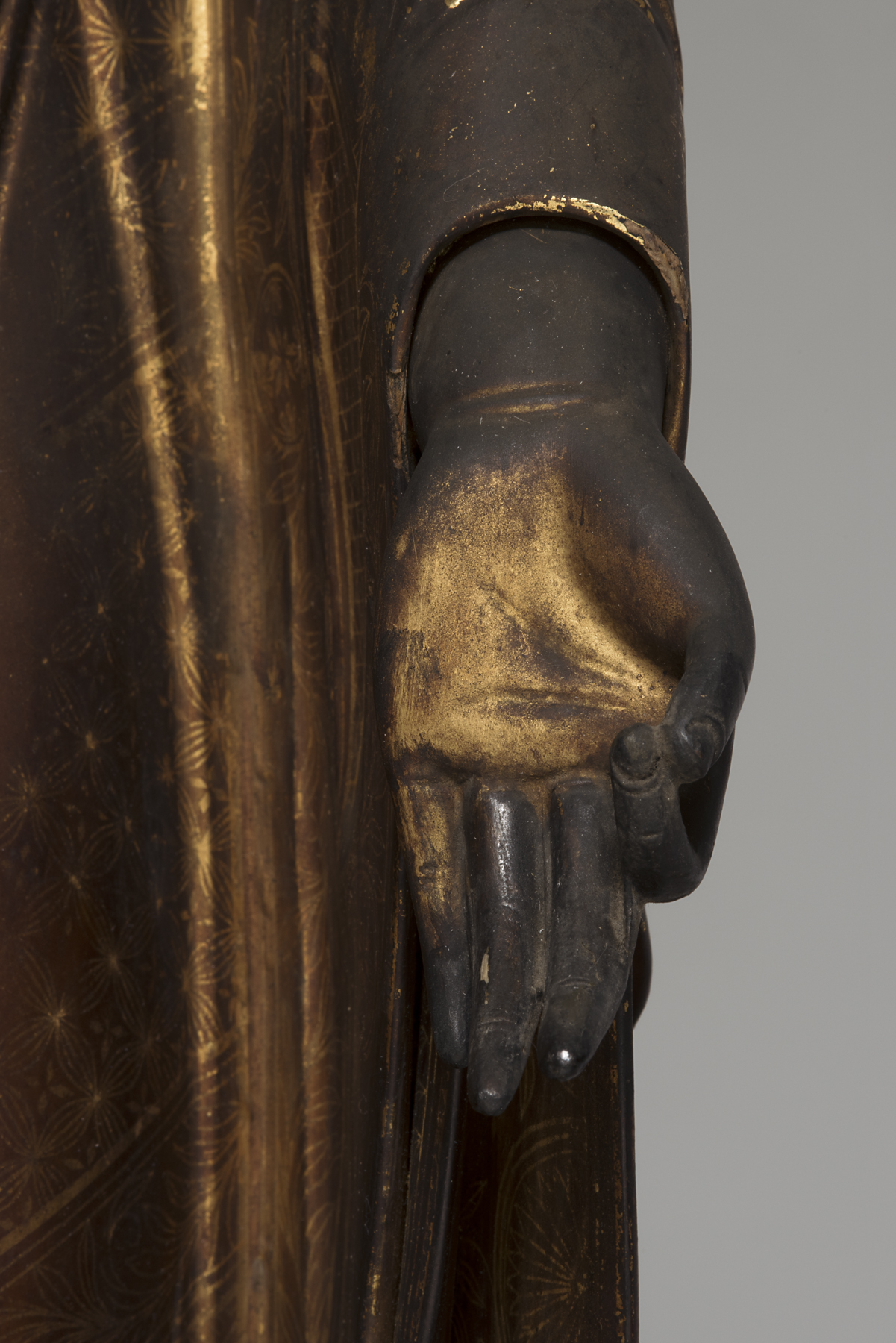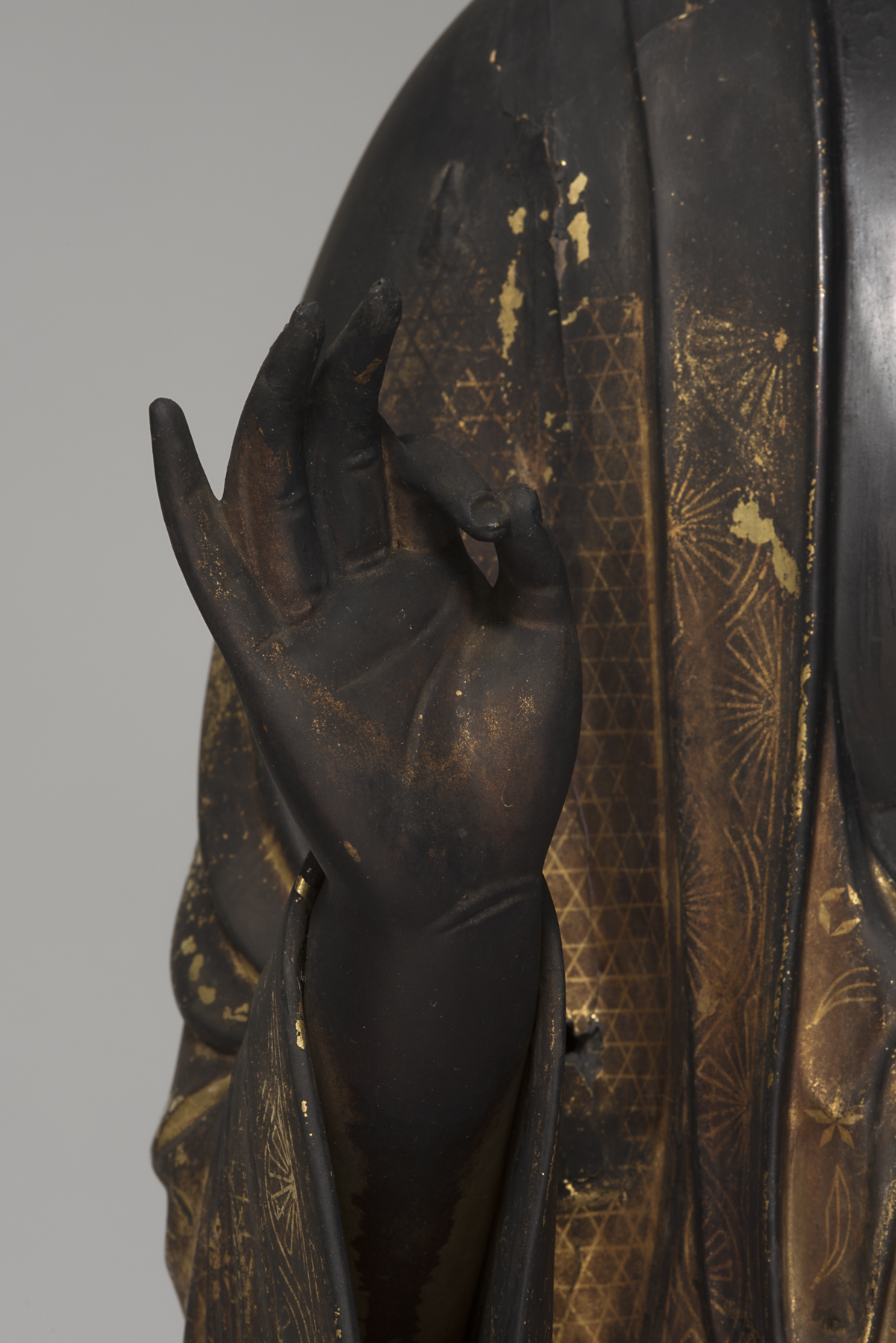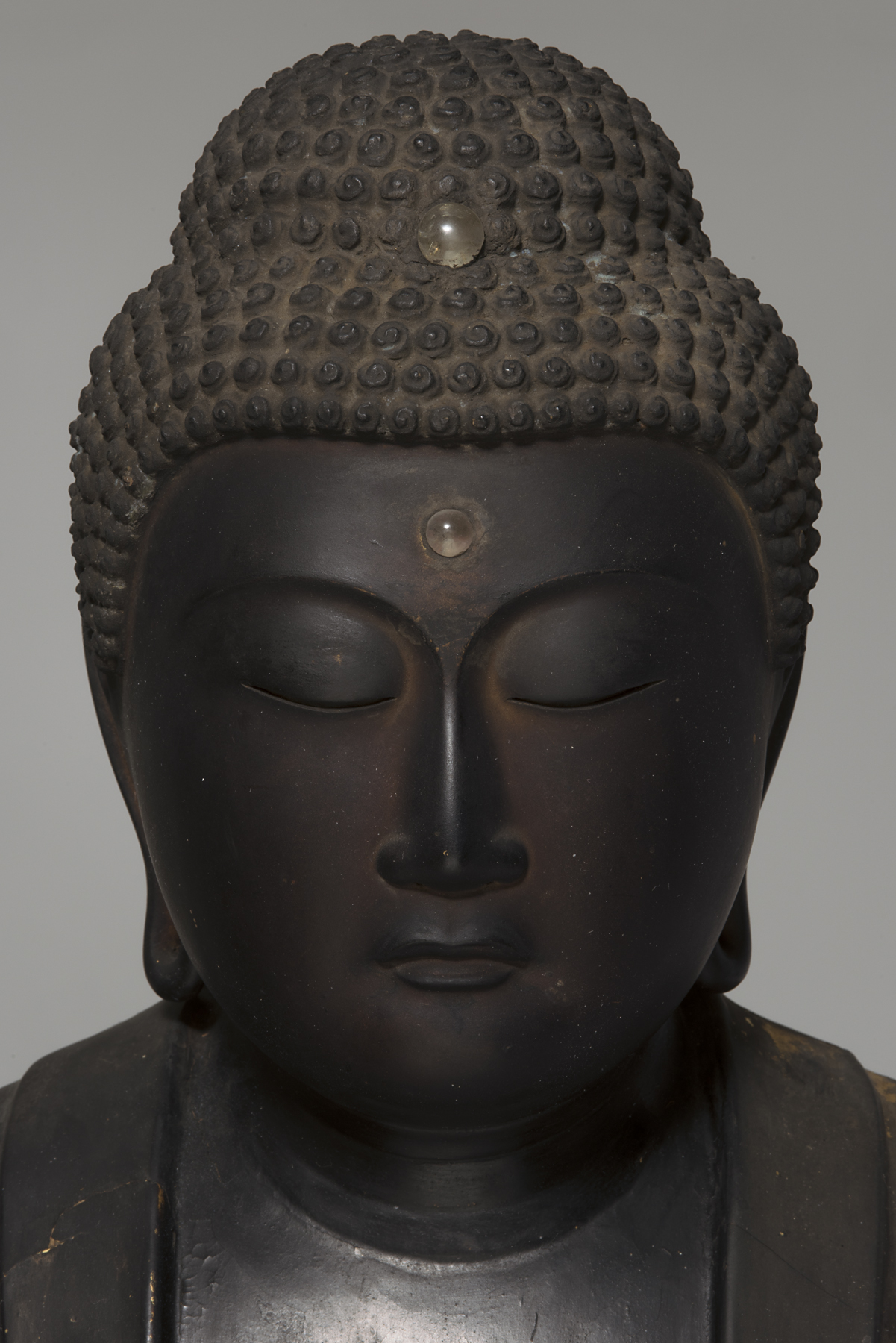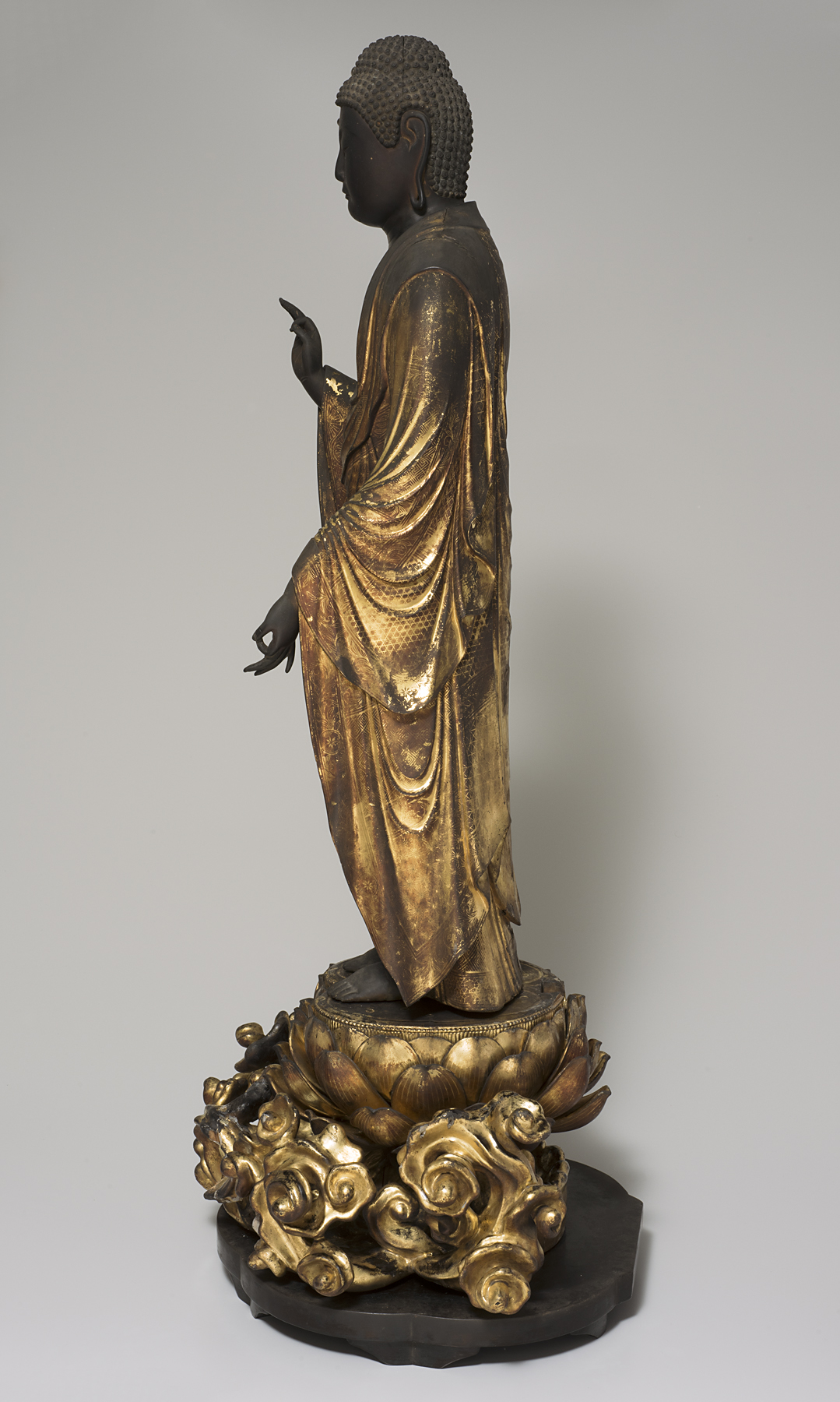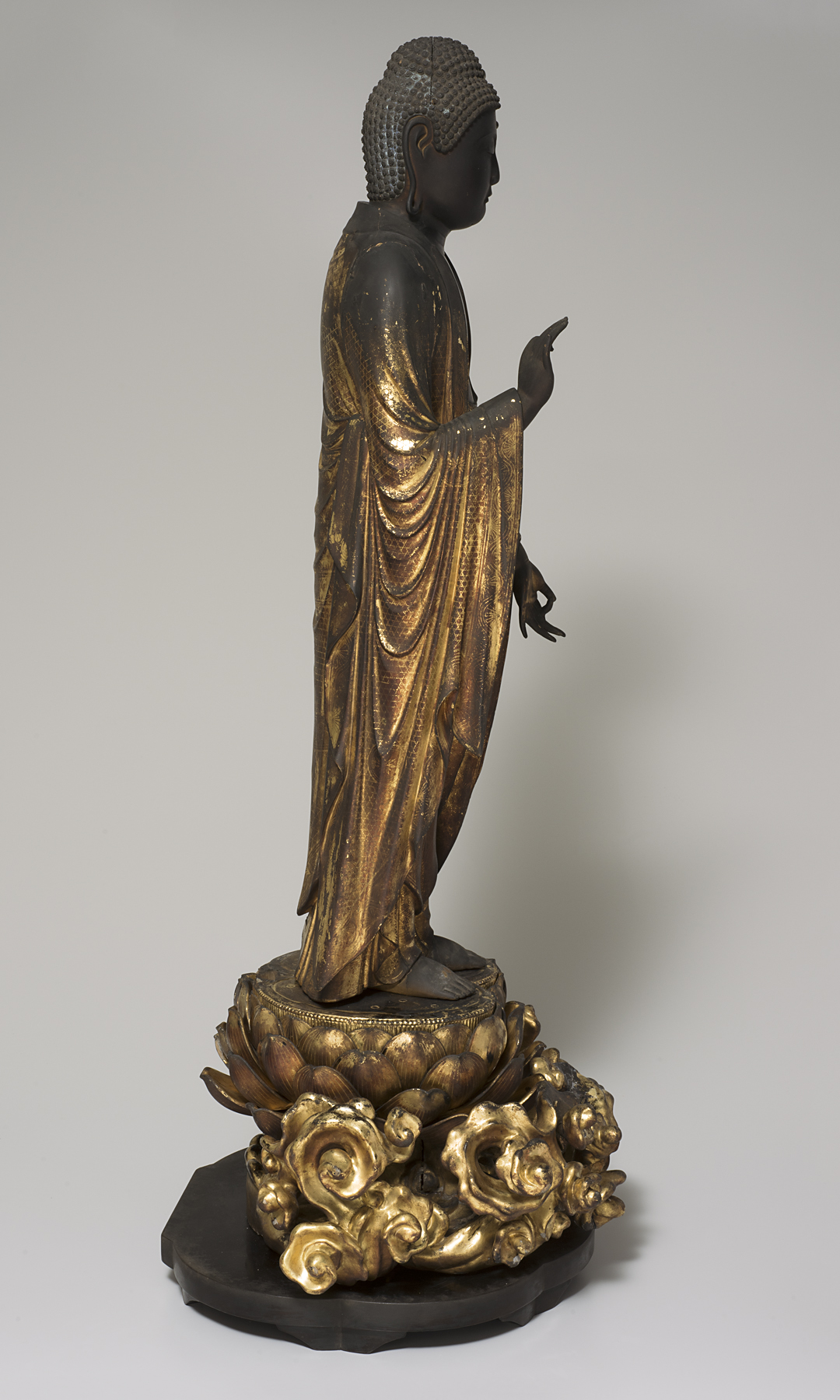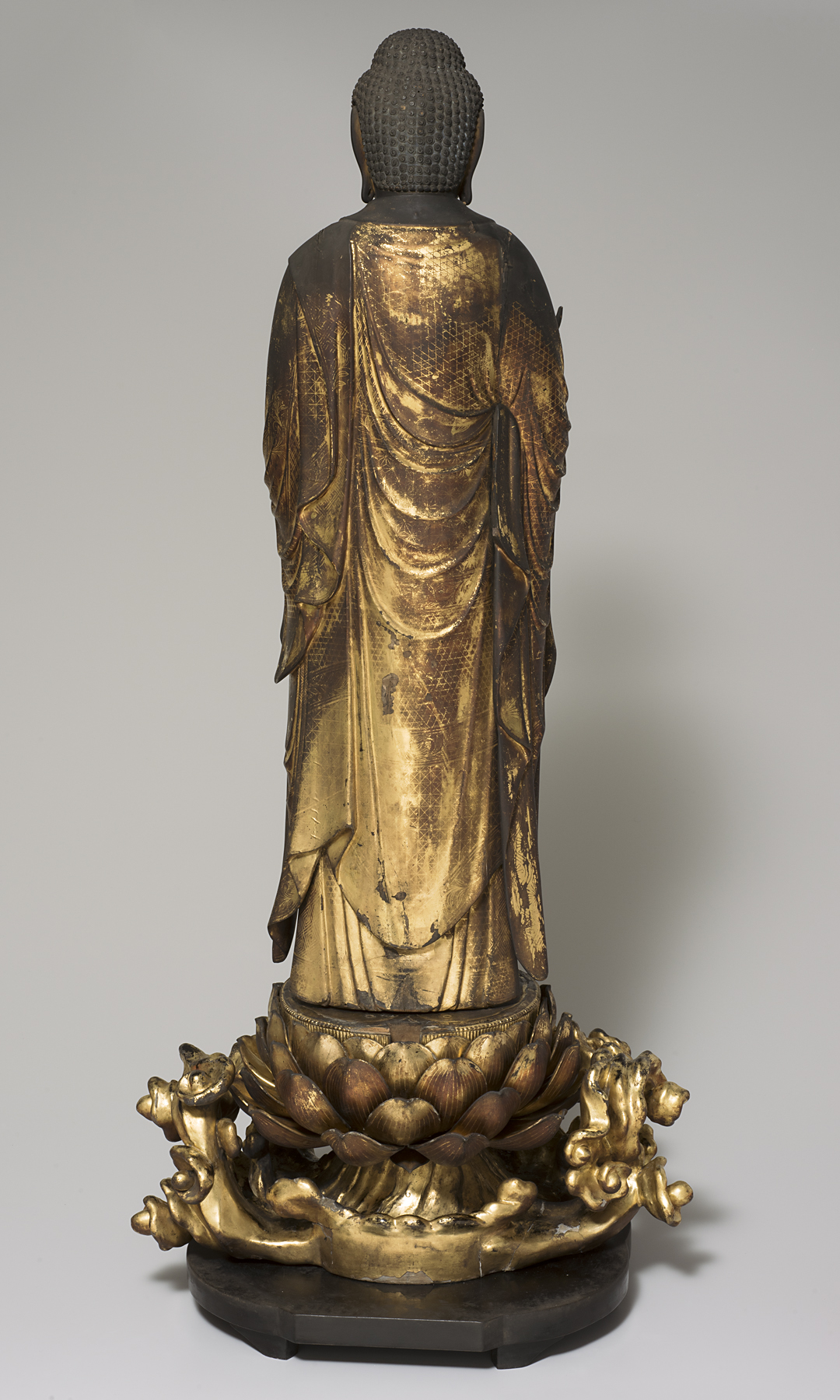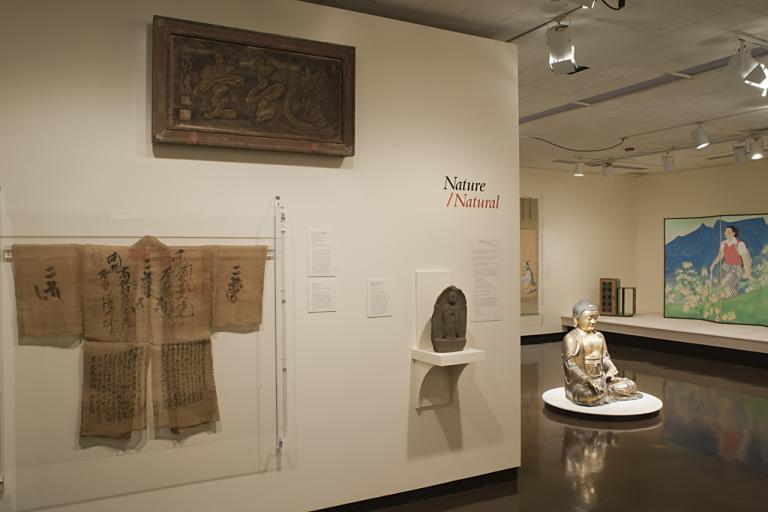Amitābha (阿弥陀仏 Amida butsu; 阿弥陀如来 Amida nyorai), unknown maker from Japan
Artwork Overview

Object Height/Width/Depth (Height x Width x Depth): 109.2 x 46.1 x 40 cm
Object Height/Width/Depth (Height x Width x Depth): 43 x 18 1/8 x 15 3/4 in
If you wish to reproduce this image, please submit an image request
Images
Label texts
Amitābha, whose name means “limitless light” in Sanskrit, is venerated in the Pure Land sect of the Mahayana Buddhist tradition. Scriptures related to Amitābha first made their way to Japan in the 7th century, but the religious figure did not become popular until three hundred years later when Buddhism was tranformed from an elite, foreign tradition into a populist religion. Pure Land Buddhism teaches mindfulness through the recitation of Amitabha’s name (namu amida butsu in Japanese) in order to attain reincarnation in Western Paradise. An accompanying hand gesture (known as a mudra in Sanskrit) welcomes deceased souls into paradise (known as raigo in Japanese). Darkened from smoke and incense, this figure’s lacquer coating, mixed with tiny slivers of gold leaf, once glowed in the flickering light of votive candles in the dim temple interior.
This type of Buddha is called Amitābha, who is associated with the Pure Land sect of the Mahayana Buddhist tradition. Tap the Web icon to watch a video describing the differences between Theravada and Mahayana Buddhism. This statue was originally placed in a Buddhist temple in Japan and still shows some smoke residue from the incense burned there. This figure’s hand gesture—known as a mudra in Sanskrit—welcomes deceased souls into paradise. The gold patterning on the Amitābha’s drapery is created by a delicate process called kirikane. Tap the Web icon to watch a video showing this process.Walk around this sculpture to view it from all angles. In what ways can you see art and religion informing each other?
This type of Buddha is called Amitābha, who is associated with the Pure Land sect of the Mahayana Buddhist tradition. This statue was originally placed in a Buddhist temple in Japan and still shows some smoke residue from the incense burned there. This figure’s hand gesture—known as a mudra in Sanskrit—welcomes deceased souls into paradise. The gold patterning on the Amitābha’s drapery is created by a delicate process called kirikane.
View images of this work from all angles. In what ways can you see art and religion informing each other?
Amitābha, which means “limitless light” in Sanskrit, is venerated in the Pure Land sect of the Mahāyana Buddhist tradition. Scriptures related to Amitābha first made their way to Japan in the seventh century, but he did not become a popular religious figure until 300 years later when Buddhism was transformed from an elite, foreign tradition into a populist religion. Pure Land Buddhism teaches mindfulness through the recitation of Amitābha’s name (namu amida butsu in Japanese) in order to attain reincarnation in Western Paradise. The figure’s hand gesture (known as a mudra in Sanskrit) welcomes deceased souls into paradise (known as raigo-in 来迎印). Now darkened from smoke and incense, the lacquer coating mixed with tiny slivers of gold leaf (called kirikane) glowed with illuminated radiance in the flickering light of votive candles in the dimly lit temple interior.
Amitābha, which means “limitless light” in Sanskrit, is venerated in the Pure Land sect of the Mahāyana Buddhist tradition. Scriptures related to Amitābha first made their way to Japan in the seventh century, but he did not become a popular religious figure until 300 years later when Buddhism was transformed from an elite, foreign tradition into a populist religion. Pure Land Buddhism teaches mindfulness through the recitation of Amitābha’s name (namu amida butsu in Japanese) in order to attain reincarnation in Western Paradise. The figure’s hand gesture (known as a mudra in Sanskrit) welcomes deceased souls into paradise (known as raigo-in 来迎印). Now darkened from smoke and incense, the lacquer coating mixed with tiny slivers of gold leaf (called kirikane) glowed with illuminated radiance in the flickering light of votive candles in the dimly lit temple interior.
Amitābha, whose name means “limitless light” in Sanskrit, is venerated in the Pure Land sect of the Mahayana Buddhist tradition. Scriptures related to Amitābha first made their way to Japan in the 7th century, but the religious figure did not become popular until three hundred years later when Buddhism was tranformed from an elite, foreign tradition into a populist religion. Pure Land Buddhism teaches mindfulness through the recitation of Amitabha’s name (namu amida butsu in Japanese) in order to attain reincarnation in Western Paradise. An accompanying hand gesture (known as a mudra in Sanskrit) welcomes deceased souls into paradise (known as raigo in Japanese). Darkened from smoke and incense, this figure’s lacquer coating, mixed with tiny slivers of gold leaf, once glowed in the flickering light of votive candles in the dim temple interior.
Didactic label content here.
Amita¯bha, whose name means “limitless light” in Sanskrit, is venerated in the Pure Land sect of the Maha¯yana Buddhist tradition. Scriptures related to Amita¯bha first made their way to Japan in the 7th century, but the religious figure did not become popular until three hundred years later when Buddhism was tranformed from an elite, foreign tradition into a populist religion. Pure Land Buddhism teaches mindfulness through the recitation of Amita¯bha’s name (namu amida butsu in Japanese) in order to attain reincarnation in Western Paradise. An accompanying hand gesture (known as a mudra in Sanskrit) welcomes deceased souls into paradise (known as raigo-in 来迎印). Darkened from smoke and incense, this figure’s lacquer coating, mixed with tiny slivers of gold leaf (called kirikane), once glowed in the flickering light of votive candles in the dim temple interior.
Amita¯bha, whose name means “limitless light” in Sanskrit, is venerated in the Pure Land sect of the Maha¯yana Buddhist tradition. Scriptures related to Amita¯bha first made their way to Japan in the 7th century, but the religious figure did not become popular until three hundred years later when Buddhism was tranformed from an elite, foreign tradition into a populist religion. Pure Land Buddhism teaches mindfulness through the recitation of Amita¯bha’s name (namu amida butsu in Japanese) in order to attain reincarnation in Western Paradise. An accompanying hand gesture (known as a mudra in Sanskrit) welcomes deceased souls into paradise (known as raigo-in 来迎印). Darkened from smoke and incense, this figure’s lacquer coating, mixed with tiny slivers of gold leaf (called kirikane), once glowed in the flickering light of votive candles in the dim temple interior.
In Pure Land Buddhism, the Amida Buddha is believed to lead souls of the deceased to the Western Paradise. As a belief system, Pure Land Buddhism first appeared in Central Asia and became widespread in China, Korea, and eventually Japan, where this sculpture was made. Pure Land teaches mindfulness through the recitation of the Amida Buddha’s name in order to attain reincarnation in Western Paradise. Through its journey from India, many of the tenets of Buddhism were transformed, but surprisingly, a wide array of visual elements remained intact. For example, the hand gesture of the Buddha (known as a mudra), the coiled hair, and the elongated earlobes are all associated with historical representations of the Buddha seen first in India, nearly a thousand years earlier.
In Pure Land Buddhism, the Amida Buddha is believed to lead souls of the deceased to the Western Paradise. As a belief system, Pure Land Buddhism first appeared in Central Asia and became widespread in China, Korea, and eventually Japan, where this sculpture was made. Pure Land teaches mindfulness through the recitation of the Amida Buddha’s name in order to attain reincarnation in Western Paradise. Through its journey from India, many of the tenets of Buddhism were transformed, but surprisingly, a wide array of visual elements remained intact. For example, the hand gesture of the Buddha (known as a mudra), the coiled hair, and the elongated earlobes are all associated with historical representations of the Buddha seen first in India, nearly a thousand years earlier.
Exhibition Label:
"Forms of Thought," Mar-2014, Kris Ercums
Amita¯bha, whose name means “limitless light” in Sanskrit, is venerated in the Pure Land sect of the Maha¯yana Buddhist tradition. Scriptures related to Amita¯bha first made their way to Japan in the 7th century, but the religious figure did not become popular until three hundred years later when Buddhism was tranformed from an elite, foreign tradition into a populist religion. Pure Land Buddhism teaches mindfulness through the recitation of Amita¯bha’s name (namu amida butsu in Japanese) in order to attain reincarnation in Western Paradise. An accompanying hand gesture (known as a mudra in Sanskrit) welcomes deceased souls into paradise (known as raigo-in 来迎印). Darkened from smoke and incense, this figure’s lacquer coating, mixed with tiny slivers of gold leaf (called kirikane), once glowed in the flickering light of votive candles in the dim temple interior.
Exhibition Label:
"Nature/Natural," Feb-2011, Kris Ercums
In Pure Land Buddhism, the Amida Buddha is believed to lead souls of the deceased to the Western Paradise. As a belief system, Pure Land Buddhism first appeared in Central Asia and became widespread in China, Korea, and eventually Japan, where this sculpture was made. Pure Land teaches mindfulness through the recitation of the Amida Buddha’s name in order to attain reincarnation in Western Paradise. Through its journey from India, many of the tenets of Buddhism were transformed, but surprisingly, a wide array of visual elements remained intact. For example, the hand gesture of the Buddha (known as a mudra), the coiled hair, and the elongated earlobes are all associated with historical representations of the Buddha seen first in India, nearly a thousand years earlier.
Exhibition Label:
"Echoes of Human Migration in the Collection of the Spencer Museum of Art," Mar-2010
In Pureland Buddhism, the Amida Buddha is believed to lead souls of the deceased to the Western Paradise. As a belief system, Pureland Buddhism first appeared in Central Asia and became widespread in China, Korea, and eventually Japan, where this sculpture was made. Through its journey from India, many of the tenets of Buddhism were transformed, but surprisingly, a wide array of visual elements remained intact. For example, the hand gesture of the Buddha (known as a mudra), the coiled hair, and the elongated earlobes are all associated with historical representations of the Buddha seen first in India, nearly a thousand years earlier.
Archive Label 2003 (version 1):
Pure Land Buddhism has been the most popular sect in Japan since the twelfth century. The central deity of Pure Land is Amida (Sanscrit: Amitahba) Buddha, whose Pure Land paradise is in the west. According to the scriptures, Amida vowed that anyone who expressed sincere faith in him would be reborn in his paradise. When believers die, Amida descends to earth to welcome their souls into his Western Pure Land.
Amida’s hands are in the position displayed when welcoming a soul to paradise (raigo-in). There are three levels of rebirth into the Pure Land, each subdivided into three classes. With hands in the present position, Amida is welcoming someone into the lower life, upper class.
Wood was the favored medium for sculpture in Japan. Following techniques that prevailed from the eleventh century, this sculpture was constructed of separate pieces of wood that were carved, hollowed out, and then assembled. The artisans then coated the image with lacquer and, to accentuate Amida’s radiance, pasted tiny slivers of gold leaf (kirikane) on his robes. The delicate cut-gold patterns made the image sparkle, especially in the flickering light of votive candles in a dim temple interior.
Archive Label 2003 (version 2):
This sculpture represents Amida (Sanskrit: Amitahba) Buddha, the central deity of Pure Land Buddhism. Amida’s compassion has made Pure Land the most popular Buddhist sect in Japan since the twelfth century. According to the Lotus Sutra, Amida vowed to save the souls of everyone who expressed sincere faith in him. When believers die, Amida descends to earth to welcome their souls into his Western Pure Land.
Amida’s hands are in the position displayed when welcoming a soul to paradise (raigo-in). There are three levels of rebirth into the Pure Land, each subdivided into three classes. This hand position (Sanskrit: mudra) indicates that Amida is welcoming a believer into the lower life, upper class.
The symmetrical fall of the drapery over the legs coupled with the soft naturalism of the face suggests a connection to the style developed by the sculptor Kaikei (1183-1223). The concern for surface decoration in gold and the interest in detailed carving of the drapery also reveal a link to the Kaikei tradition.
Following techniques that prevailed from the eleventh century, this sculpture was constructed of separate pieces of wood that were carved, hollowed out, and then assembled. The artisans then coated the image with lacquer and, to accentuate Amida’s radiance, pasted tiny slivers of gold leaf (kirikane) on his robes. The delicate cut-gold patterns articulate the surface and made the image sparkle in the flickering light of votive candles in a dim temple interior.
Archive Label 2003 (version 3):
This sculpture represents Amida (Sanskrit: Amitabha) Buddha, the central deity of Pure Land Buddhism. Amida’s compassion and saving grace have made Pure Land the most popular Buddhist sect in Japan since the twelfth century. According to the Lotus Sutra, Amida vowed that anyone who expressed sincere faith in him would be reborn in his paradise. Here Amida’s hands perform one of the nine gestures, collectively called raigo-in, that indicate he is welcoming a believer into his Western Pure Land.
The symmetrical fall of the drapery over the legs coupled with the soft naturalism of the face suggests a connection to the style developed by the sculptor Kaikei (1183-1223). The detailed carving of the drapery and elegant surface decoration in gold also link the sculpture to the Kaikei tradition.
Following techniques that prevailed from the eleventh century, this sculpture was constructed of separate pieces of wood that were carved, hollowed out, and then assembled. The artisans then coated the image with lacquer and, to accentuate Amida’s radiance, pasted tiny slivers of gold leaf (kirikane) on his robes. The delicate cut-gold patterns articulating the surface would have made the image sparkle in the flickering light of votive candles in a dim temple interior.
